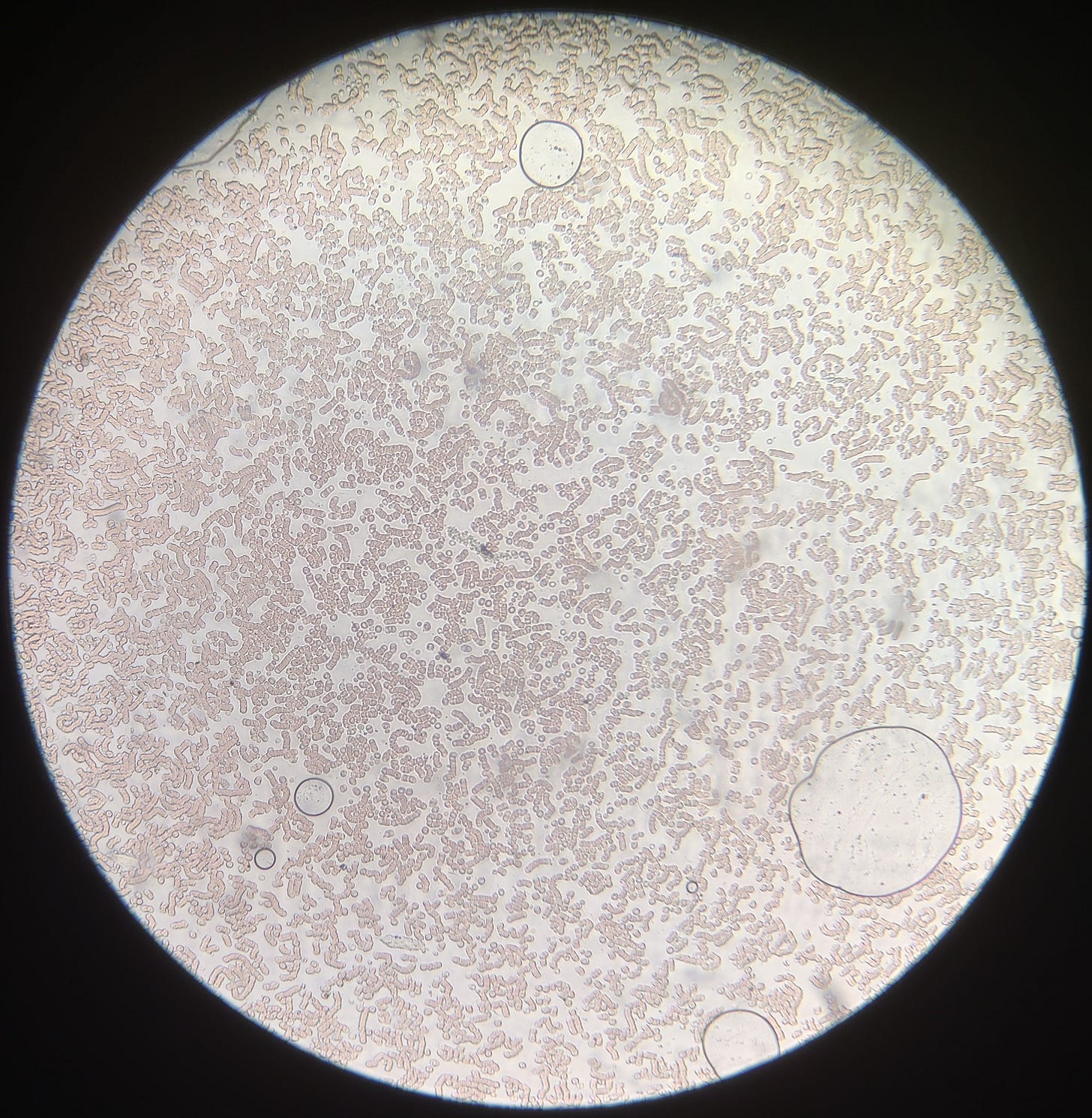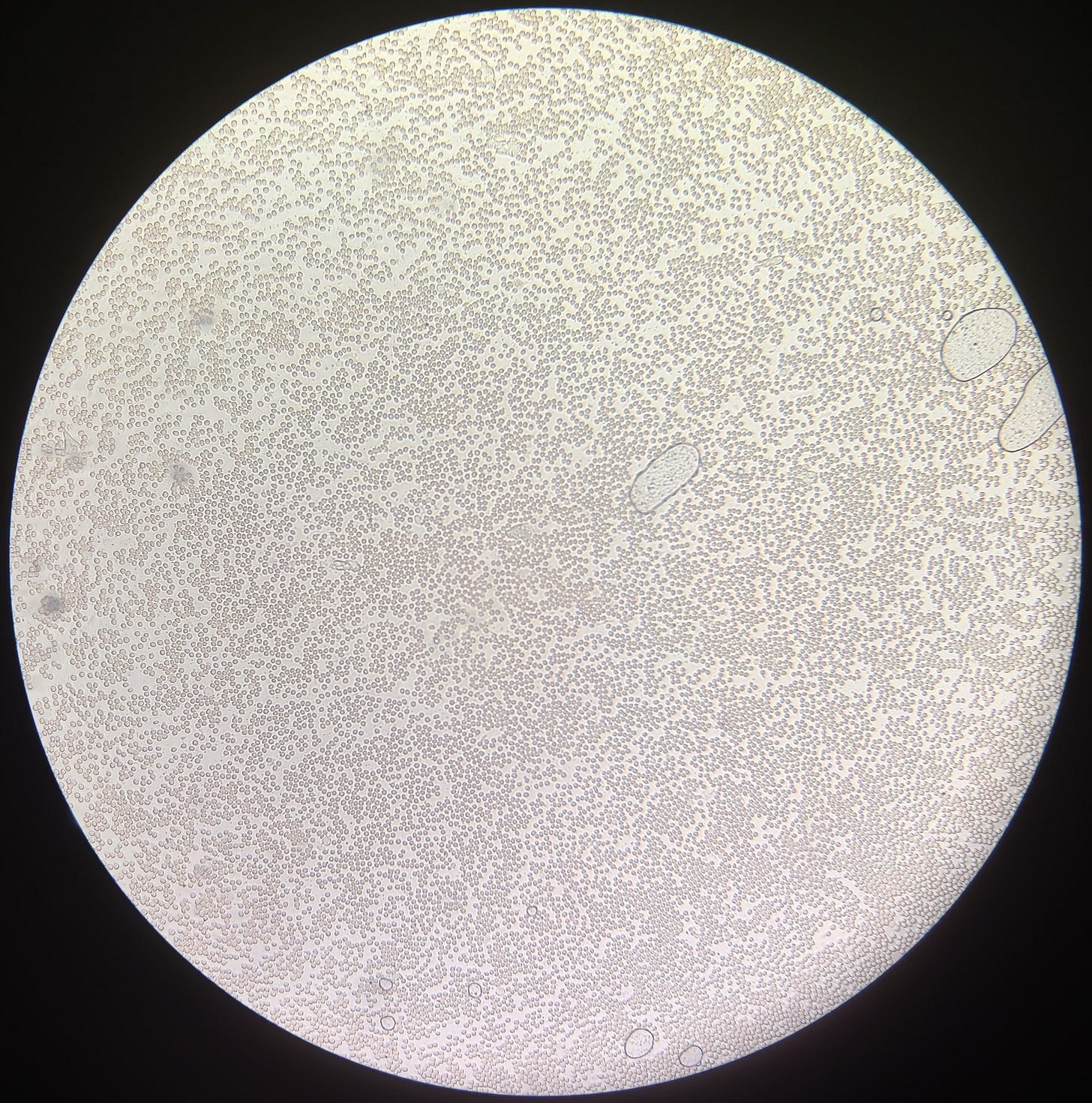Decrease EMF exposure
There have been hundreds of animal and human studies linking exposure to electromagnetic fields to a variety of health problems, including cancer, high blood pressure, hormonal changes, inflammation, a variety of mental health issues, disrupted sleep, altered function of calcium channels, and poor microcirculation. Many of the studies are poorly designed. Many of the studies are conflicting. However, some of the studies are compelling, such as these: 1234567891011121314151617181920212223242526272829
Yet, for the longest time I remained skeptical; and then I came across some anecdotal reports of electric fields causing red blood cell clumping, a sure indicator of inflammation. This was something I could test at home. Here is what I did:
I sat at my office desk, in front of all my computer monitors, in proximity to various other electrical devices, for 30 minutes. Then I took a drop of my blood, smeared it onto a slide, and looked at it under a microscope. Lo and behold, significant clumping of my red blood cells:
Next, I sat at the same location for an additional 30 minutes, this time with my feet on a grounding mat. The grounding mat works by dissipating the body voltage induced by nearby electric fields. (I had already confirmed that my mat works using a voltmeter.)
I then took another drop of my blood:
No more clumping!
This was enough to make me a believer. I subsequently took the following steps to mitigate my exposure to EMF, which I now pass along to you, in progressive levels of tin-foil-hattedness:
Put your phone on airplane mode when it is in your pocket. IPhone users may have to separately turn off their Bluetooth and Wi-Fi antennas.
Don't sit or sleep right next to your Wi-Fi router. Consider turning it off at night.
Use your phone on speakerphone mode or get a set of wired headphones.
Don't use your laptop on your lap.
Buy shielded electrical cords and shielded power strips for your workspace devices.
Don't have an electric alarm clock, lamp, or other electrical device right next to you while you are sleeping. Note should be made that even when a lamp is turned off, there are still electrical fields generated along the wires. Similarly, there are electric fields constantly emanating from the wires in the walls of your home, so it is best not to sit or sleep right next to a wall. You can test for electric fields in your home (as well as magnetic fields and RF radiation) using a something called a multifield meter. I like the GQ EMF-390.
If you want to go to the extra mile, turn off the circuit breaker to your bedroom at night.
If you do not want to turn off your circuit breaker at night, consider using a grounding mat on your bed. Also consider using a grounding mat at your computer desk if you spend a lot of time there. Grounding mats can be connected to the ground portion of any electrical outlet, but it is better to have them connected to a ground stake outside.
https://pubmed.ncbi.nlm.nih.gov/29268055/
https://pubmed.ncbi.nlm.nih.gov/25918601/
https://pubmed.ncbi.nlm.nih.gov/25456509/
https://pubmed.ncbi.nlm.nih.gov/24816517/
https://pubmed.ncbi.nlm.nih.gov/24861496/
https://pubmed.ncbi.nlm.nih.gov/24982785/
https://pubmed.ncbi.nlm.nih.gov/22769405/
https://pubmed.ncbi.nlm.nih.gov/22433632/
https://pubmed.ncbi.nlm.nih.gov/22047460/
https://pubmed.ncbi.nlm.nih.gov/21659469/
https://pubmed.ncbi.nlm.nih.gov/20857453/
https://pubmed.ncbi.nlm.nih.gov/19879861/
https://pubmed.ncbi.nlm.nih.gov/18804757/
https://pubmed.ncbi.nlm.nih.gov/22112647/
https://pubmed.ncbi.nlm.nih.gov/22131325/
https://pubmed.ncbi.nlm.nih.gov/20230292/
https://pubmed.ncbi.nlm.nih.gov/8986367/
https://pubmed.ncbi.nlm.nih.gov/30023251/
https://www.sciencedirect.com/science/article/abs/pii/S0969806X19305481
https://pmc.ncbi.nlm.nih.gov/articles/PMC3576907/
https://ijmrr.medresearch.in/index.php/ijmrr/article/view/331
https://pubmed.ncbi.nlm.nih.gov/28451526/
https://www.rjb.ro/articles/283/art05AbdeAziz.pdf
https://pubmed.ncbi.nlm.nih.gov/34630149/
https://pubmed.ncbi.nlm.nih.gov/22138021/
https://pubmed.ncbi.nlm.nih.gov/27454187/
https://pubmed.ncbi.nlm.nih.gov/10188140/
https://pubmed.ncbi.nlm.nih.gov/28124386/
https://pmc.ncbi.nlm.nih.gov/articles/PMC3780531/



